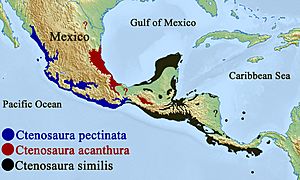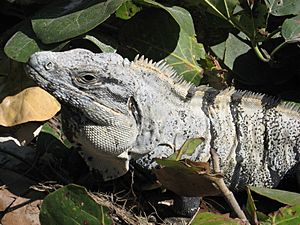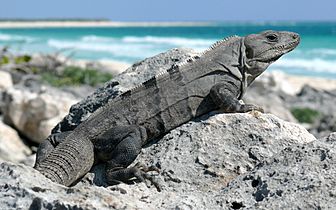Black iguana facts for kids
Quick facts for kids Black iguana |
|
|---|---|
 |
|
| in Belize | |
| Conservation status | |
| Scientific classification | |
| Genus: |
Ctenosaura
|
| Species: |
similis
|
 |
|
| Synonyms | |
|
|
The black spiny-tailed iguana, also called the black iguana, is a type of lizard. Its scientific name is Ctenosaura similis. This lizard naturally lives in Mexico and Central America.
You can also find them on some Colombian islands. They have also been introduced to Florida in the United States. This iguana is the biggest species in its group, Ctenosaura. They usually live in places like grasslands and forests.
Contents
About the Black Spiny-tailed Iguana
The black spiny-tailed iguana was first described in 1831. A British zoologist named John Edward Gray gave it its scientific name. The name Ctenosaura comes from two old Greek words. Ctenos means "comb," which refers to the comb-like spines on the lizard's back and tail. Saura means "lizard."
Its specific name, similis, is a Latin word meaning "similar to." This name is often used in Linnean taxonomy when a new animal looks like another one.
What Does It Look Like?

Black spiny-tailed iguanas have special black scales on their long tails. These scales are ridged, which gives them their common name. They are among the largest lizards in the Ctenosaura group.
Male iguanas can grow up to about 1.3 meters (4.3 feet) long. Females are a bit shorter, usually between 0.8 and 1 meter (2.6 to 3.3 feet). They have a crest of long spines that runs down the middle of their back.
Their colors can vary a lot, even among iguanas from the same area. Adults are often whitish-gray or tan. They have 4 to 12 dark bands across their back. During breeding season, males get orange colors around their head and throat. They may also have blue and peach highlights on their cheeks.
Diet and Behavior
Black spiny-tailed iguanas are very good climbers. They like rocky places with lots of cracks to hide in. They also enjoy rocks for basking in the sun and nearby trees to climb. They are active during the day and move very fast.
They use their speed to escape from animals that might try to eat them. If they get trapped, they will whip their tails and bite. The Guinness Book of World Records lists this lizard as the fastest in the world. It can run as fast as 34.6 kilometers per hour (21.5 mph).
These iguanas mostly eat plants. Their diet includes flowers, leaves, stems, and fruit. However, they will also eat smaller animals if they get the chance. This can include small rodents, bats, frogs, small birds, and even smaller iguanas. They also eat eggs and insects. Young iguanas tend to eat more insects. As they get older, they eat more plants. They are even known to eat the fruit of the manchineel tree, which is very poisonous to most other animals.
Where Do They Live?
The black spiny-tailed iguana is native to southern Mexico and Central America. They live from the Isthmus of Tehuantepec down to Panama. They can be found from sea level up to about 1,320 meters (4,330 feet) high.
Their natural home includes parts of Mexico, Belize, Guatemala, and Honduras. They also live in El Salvador, Nicaragua, and Costa Rica. They are found on many islands in the Caribbean and Pacific.
These iguanas have also been introduced to other places. They are now found in southern Florida and some islands in the Bahamas. They have also been seen on Malpelo Island in Colombia and in Venezuela. In Florida, they have spread and now live in the wild.
Because these iguanas sometimes eat small animals, they can be a threat. They might eat fish, rodents, eggs, birds, and even baby sea turtles. This could harm native species that are already in danger.
How They Reproduce
Mating for black spiny-tailed iguanas usually happens in the spring. Male iguanas show their interest by bobbing their heads. The male will then chase the female until he can catch her.
About eight to ten weeks later, the female will dig a nest. She can lay up to 30 eggs at one time. The eggs hatch after about 90 days. The baby iguanas then dig their way out of the sand. Young iguanas are usually green with brown marks. However, some baby iguanas have been seen that are all brown.
Commercial Use
In some parts of Central America, people call the black spiny-tailed iguana the "chicken of the trees." This is because they are raised for food. They are also sold for the pet trade. Even though many are hunted, they do not seem to be in danger in their native homes.
Gallery
See also
 In Spanish: Garrobo negro para niños
In Spanish: Garrobo negro para niños





